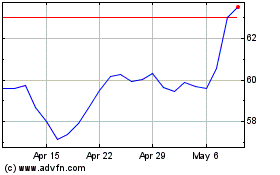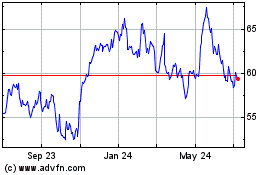Pfizer Inc. and Allergan PLC agreed on a historic merger deal
worth more than $150 billion that would create the world's biggest
drug maker and move one of the top names in corporate America to a
foreign country.
The boards of each company ratified the deal Sunday and it could
be announced Monday, according to people familiar with the matter.
The final terms include 11.3 Pfizer shares for every Allergan share
and the deal also contains a small cash component, they said.
The takeover would be the largest so-called inversion ever. Such
deals enable a U.S. company to move abroad and take advantage of a
lower corporate tax rate elsewhere, and have remained popular in
the face of U.S. efforts to curb them.
To help secure that lower tax rate, the deal will be technically
structured as a reverse merger, with Dublin-based Allergan, which
is smaller, buying New York-based Pfizer, according to the
people.
Pfizer Chief Executive Ian Read will lead the combined company
with Allergan CEO Brent Saunders serving as his No. 2, with the
titles of president and chief operating officer, some of the people
said. Other Allergan executives are expected to join the firm,
too.
Mr. Read has railed against high U.S. corporate tax rates, which
he says puts American-based companies like Pfizer at a competitive
disadvantage to their overseas rivals. Pfizer's tax rate is about
25%, the highest among its Big Pharma peers, according to Evercore
ISI.
Last year, Pfizer tried to ink a tax-lowering deal for
AstraZeneca PLC but its British rival rejected the overtures,
sending Mr. Read back to the drawing board.
In hooking up with Allergan, Pfizer would lower its tax rate
below 20%, analysts estimate. Allergan, itself the product of a
tax-lowering inversion deal, has a roughly 15% tax rate.
The combination will also create a pharmaceutical behemoth, with
top-selling products including Pfizer's Prevnar pneumonia vaccine
and Allergan's antiwrinkle treatment Botox, and an industry-topping
R&D budget.
The company's drugs and vaccines would cover a range of
diseases, from Alzheimer's to cancer, eye health to rheumatoid
arthritis.
The deal would bring together two pharmaceutical powerhouses
with more than $60 billion in combined sales. Last year, Actavis,
which bought Allergan and took its name, had more than $13 billion
in sales, while Pfizer had nearly $50 billion in revenue.
Pfizer could benefit from the faster growth of Allergan. After
coping with sales lost when blockbusters like cholesterol-fighter
Lipitor faced generic competition, Pfizer has notched successes
launching new drugs like breast-cancer tablets Ibrance.
Yet Allergan has been growing at a faster rate, partly thanks to
Botox and its other aesthetic-medicine products, which dominate a
market that Allergan forecasts will double to $10.5 billion by
2020.
In addition, Allergan predicts that it could launch more than a
dozen new products, including drugs for age-related macular
degeneration and depression, over the next several years that could
add more than $15 billion in sales.
The combined company will have more resources to devote to drug
research and development.
The deal comes days after the Treasury Department released new
rules aiming to curb tax-lowering inversion deals. Analysts said
the rules didn't appear to be able to thwart a combination of
Pfizer and Allergan, though the risk of government action
remains.
For the deal to go forward, the companies will have to receive
approval from antitrust regulators around the world.
The combination would further the rapid pace of consolidation in
health care, in which companies of all stripes—from insurers to
hospitals—have been linking arms to position themselves better in
an environment of dramatic change as a result of the Affordable
Care Act and other developments.
Drug companies, especially midsize companies, have been
aggressive at M&A in recent years in order to build the heft
needed to negotiate strongly with health plans, drug-benefit
managers and hospitals over the price of medicines.
Aside from giving Pfizer the opportunity to lower its corporate
tax rate, the deal would increase its sales growth and afford
cost-cutting opportunities. For Allergan, meantime, a combination
will allow it to take sales, which are predominantly in the U.S.,
to other international markets.
Allergan itself is the result of a number of mergers in quick
succession. It started off as a generic-drug company called Watson
Pharmaceuticals Inc. In 2012, Watson acquired Swiss rival Actavis
Group and adopted that name. It also absorbed Warner Chilcott PLC
and Forest Laboratories Inc. in multibillion-dollar deals.
Mr. Saunders was CEO of Forest Labs, and became CEO of Actavis
after that deal. Shortly after, Allergan's predecessor was put into
play when Valeant Pharmaceuticals International Inc. made an
unsolicited offer to buy the California company.
Actavis then stepped in as a white knight and bought Allergan,
taking the company's name.
Meanwhile, in July, Allergan agreed to sell its generics
business to Israel's Teva Pharmaceutical Industries Ltd. for more
than $40 billion.
The companies expect it will take seven to nine months for the
deal to close, sometime after Allergan finishes the Teva deal early
next year, the people said.
After the deal closes, the combined company is expected to
evaluate splitting into two businesses, one focused on
patent-protected products and the other on drugs that have lost
their patent protection or are close to losing it.
Write to Jonathan D. Rockoff at Jonathan.Rockoff@wsj.com and
Dana Mattioli at dana.mattioli@wsj.com
Access Investor Kit for "AB InBev"
Visit
http://www.companyspotlight.com/partner?cp_code=P479&isin=BE0003793107
Access Investor Kit for "AB InBev"
Visit
http://www.companyspotlight.com/partner?cp_code=P479&isin=US03524A1088
Subscribe to WSJ: http://online.wsj.com?mod=djnwires
(END) Dow Jones Newswires
November 22, 2015 20:25 ET (01:25 GMT)
Copyright (c) 2015 Dow Jones & Company, Inc.
Anheuser Busch Inbev SA NV (NYSE:BUD)
Historical Stock Chart
From Mar 2024 to Apr 2024

Anheuser Busch Inbev SA NV (NYSE:BUD)
Historical Stock Chart
From Apr 2023 to Apr 2024
